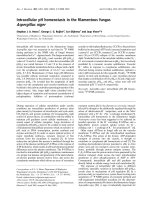Báo cáo y học: "Usefulness of vitrectomy in the treatment of ocular toxoplasmosis"
Bạn đang xem bản rút gọn của tài liệu. Xem và tải ngay bản đầy đủ của tài liệu tại đây (106.3 KB, 1 trang )
Int. J. Med. Sci. 2009, 6
139
I
I
n
n
t
t
e
e
r
r
n
n
a
a
t
t
i
i
o
o
n
n
a
a
l
l
J
J
o
o
u
u
r
r
n
n
a
a
l
l
o
o
f
f
M
M
e
e
d
d
i
i
c
c
a
a
l
l
S
S
c
c
i
i
e
e
n
n
c
c
e
e
s
s
2009; 6(3):139
© Ivyspring International Publisher. All rights reserved
Short Communication
Usefulness of vitrectomy in the treatment of ocular toxoplasmosis
Etienne H. Bovey
Hôpital Ophtalmique Jules Gonin, Lausanne (Switzerland)
Published: 2009.03.19
Although not useful in acute ocular toxoplas-
mosis, vitrectomy can be indicated at a later stage for
the management of complications such as persistent
vitreous opacification, secondary epimacular mem-
brane, and retinal detachment.
In some cases, vitreous opacification can persist
despite intensive antibiotic and steroid treatment.
After 2 or 3 months of treatment, we must ask the
following questions: is the vitreous opacification due
to inflammatory cells or to vitreous degeneration? Is it
still possible to reduce it with steroids ? If opacifica-
tion is due to large vitreous cords and secondary vit-
reous degeneration, steroid treatment is no longer
indicated and vitrectomy could be proposed in order
to clear the posterior cavity, to improve the visual
acuity and to avoid overtreatment with steroids.
Epimacular membranes secondary to toxoplas-
mosis are not much different from idiopathic ones,
and the postoperative prognosis is good.
Retinal detachment is rare. It can be either
rhegmatogenous and/or tractional.
In some rare cases, vitrectomy is indicated in the
management of the acute phase, especially when the
diagnosis is not clear. Vitrectomy can help rule out
ocular lymphoma and viral retinitis. At the beginning,
vitrectomy should be performed, with the infusion
turned off, until the eye collapses. Generally, we can
obtain 1 cc of undiluted vitreous. Once the infusion is
turned on, other syringes are used for the collection of
peripheral vitreous. With this material, it is possible to
examine the lymphocytes and perform PCR. Viruses
can be detected as well by PCR.
Vitrectomy increases the clearance of the poste-
rior cavity. Some specialists believe that it can fa-
vorably influence the evolution of uveitis, although
this point is debatable. In our series of eight cases of
vitrectomy performed for toxoplasmosis, one case is
interesting in this respect. A 40 year old woman vis-
ited us for the 7th recurrence of toxoplasmosis. On
fundus examination, we could see the consecutive
scars of previous infection along the upper temporal
arcade. At the end of this chain, there was a large pe-
ripheral active retinochoroiditis, measuring 2 disc
diameters. This lesion was treated with antibiotics
and steroids, but despite several months of treatment,
a dense network of vitreous cords persisted. Because
of decreased visual acuity and vitreous debris, a
vitrectomy was performed. No further recurrence was
observed during a follow-up of twenty years. One can
ask if vitrectomy had not removed factors that could
be implicated in the recurrence process.









